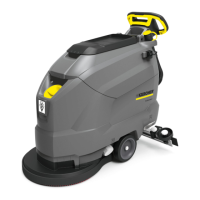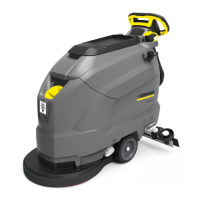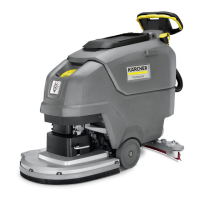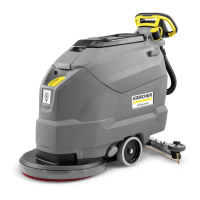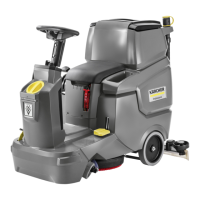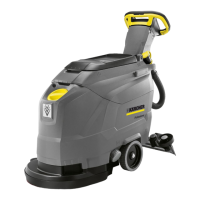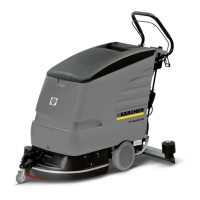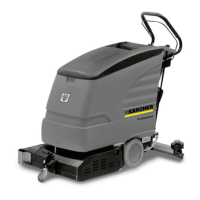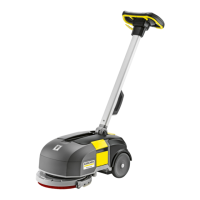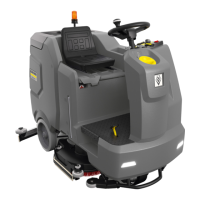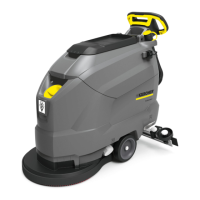
Do you have a question about the Kärcher BD 50/50 C Bp Pad AGM and is the answer not in the manual?
| Working Width of Brushes | 510 mm |
|---|---|
| Working Width of Vacuum | 900 mm |
| Fresh Water Tank Capacity | 50 l |
| Dirty Water Tank Capacity | 50 l |
| Brush Rotation Speed | 180 rpm |
| Battery Voltage | 24 V |
| Sound Level | 66 dB(A) |
| Working Speed | 4 km/h |
| Battery Type | AGM |
| Brush Contact Pressure | 27 g/cm² |
General warnings to reduce risks of fire, shock, injury, and ensure proper grounding and indoor use.
Detailed instructions for proper grounding to reduce electric shock risk.
Outlines the owner's responsibility to understand and follow operating instructions and warnings.
Safety rules for operating the unit, maintaining safe distances, and travelling.
Procedures for reporting unsafe conditions and ensuring the unit is safe to operate.
Guidelines for maintenance, fire prevention, and cleaning fluids.
Explanation of safety devices, including the safety switch function.
Defines DANGER, WARNING, CAUTION, and ATTENTION levels for hazards.
Describes the wet cleaning of level floors with adjustable water and detergent volume.
Highlights fresh/waste water tanks, working distance, and manual propulsion with brush drive.
Specifies suitable hard surfaces and operations, excluding frozen grounds.
Lists environments, materials (flammable liquids, acids), and conditions to avoid.
Instructions for recycling packaging and disposing of old appliances and substances.
Information on ingredients (REACH) is available on the Kärcher website.
Details warranty terms, repair conditions, and how to contact for claims.
Lists and identifies all numbered components of the appliance based on the illustration.
Explains the colour coding for operating elements (yellow) and controls (light gray).
Describes the function of the ON/OFF switch, program selection, and display.
Explains the meaning of various symbols found on the machine.
Step-by-step instructions for safely removing the appliance from the pallet.
Guidance on installing batteries, using chargers, and connecting them safely.
Instructions for correctly installing the vacuum bar and suction hose.
Guidance on filling the fresh water reservoir and adding recommended detergents.
Adjusting water volume and setting the vacuum bar for optimal cleaning results.
Steps to safely shut down the appliance, including raising the vacuum bar.
Instructions for draining the dirt water tank and rinsing it.
Tasks to perform after each use, including draining, rinsing, and cleaning.
Routine checks and maintenance tasks to be performed weekly and monthly.
Requirement for a yearly prescribed inspection by customer service.
Steps for removing, cleaning, and reinserting the sieve.
Instructions for replacing or reversing worn vacuum lips on the vacuum bar.
Safety precautions for transporting the appliance, including gradient limits and securing.
Guidelines for storing the appliance, emphasizing indoor storage.
Safety measures before performing maintenance, including setting switch to OFF and unplugging.
Measures to take in case of frost danger, including emptying tanks and storing indoors.
Step-by-step guide for replacing the disk brushes on the cleaning head.
Instructions for draining and removing the waste water tank.
Important warnings for handling batteries, including eye protection and explosion risks.
Lists recommended batteries and provides instructions for installation and connection.
Steps for safely removing batteries, including clamping poles and cables.
Table detailing error codes displayed on the unit and their corresponding corrections.
Troubleshooting for faults not indicated by a console display.
Lists various accessories for different cleaning tasks with their part numbers.
Provides technical data for power, vacuuming, cleaning brushes, and dimensions.
Emphasizes using original accessories and spare parts for safe operation.
